Scholars, activists brief lawmakers on role of Christian nationalism at insurrection
The meeting, which included Rep. Jamie Raskin, was a rare instance of lawmakers openly discussing the prominence of religious expression during the attack.
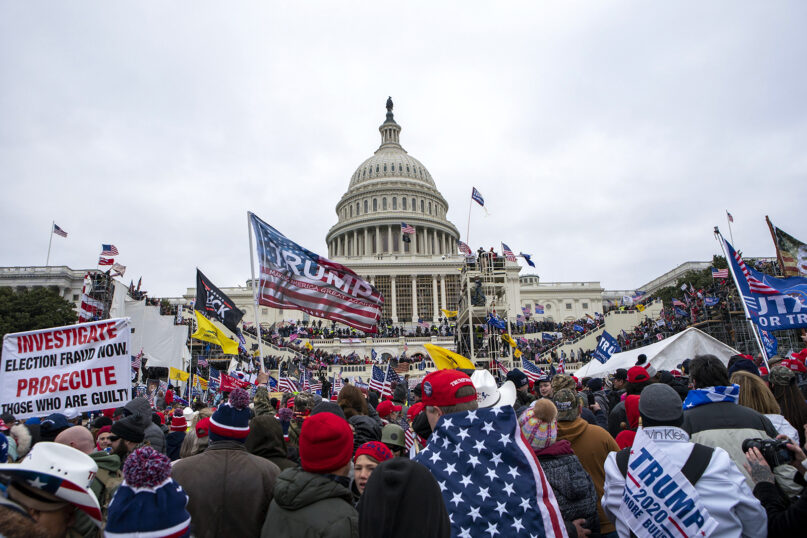
WASHINGTON (RNS) — Members of the Congressional Freethought Caucus met with a group of scholars and activists on Thursday evening (March 17) to review a new report detailing the role Christian nationalism played in the insurrection that took place at the U.S. Capitol on Jan. 6, 2021.
The meeting was a rare instance of lawmakers openly addressing the prominence of religious expression during the attack, which was evident on Jan. 6 but has not been a central focus of public discussions on Capitol Hill.
California Democratic Rep. Jared Huffman, who said he first discussed the role of Christian nationalism and the insurrection with some of the panelists last summer, hosted the meeting for a slate of lawmakers that included Maryland Rep. Jamie Raskin, a co-founder of the Freethought Caucus who also serves on the House Select Committee investigating the attack.
Raskin opened the virtual briefing by noting that while a variety of ideologies were represented among insurrectionists, Christian nationalism “clearly figured highly in the events of the day,” and was “a unifying theme for many of the factions that assembled on January 6.”
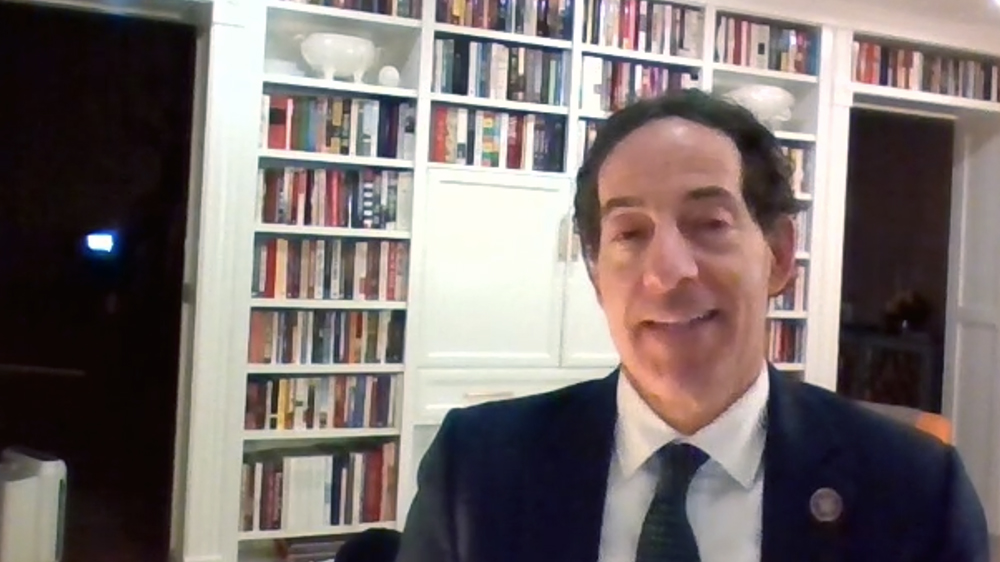
Maryland Rep. Jamie Raskin on Thursday, March 17, 2022. Video screen grab
His words were echoed by an array of panelists who presented findings from a recent report they helped author with backing from the Freedom from Religion Foundation and the Baptist Joint Committee for Religious Liberty. Among other things, the 66-page study documents in painstaking detail the prevalence of Christian nationalist symbols and rhetoric at the insurrection and a series of events that led up to the storming of the Capitol.
RELATED: How the Capitol attacks helped spread Christian nationalism in the extreme right
Amanda Tyler, head of the BJC, told lawmakers the report faced “defensive pushback” from some conservative Christians after it was unveiled last month but has been embraced by Christians who see opposing Christian nationalism as a religious call.
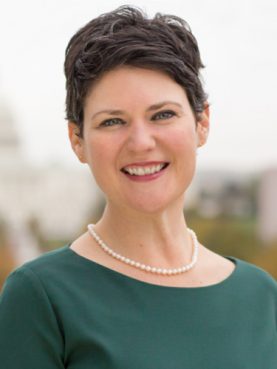
Amanda Tyler. Photo courtesy of Baptist Joint Committee
“Let’s be clear: Christianity does not and cannot unite Americans under a national identity,” Tyler said, adding that Christian nationalism “debases Christianity.”
Samuel Perry, a University of Oklahoma sociologist and co-author of “Taking America Back for God: Christian Nationalism in the United States,” told lawmakers he and others who study the ideology often use the more specific term “white Christian nationalism,” because data indicates Christian nationalist sentiments appear to “perform differently when white Americans affirm them as opposed to non-white Americans.”
He was followed by Jemar Tisby, a historian and head of Black Christian collective The Witness, who contrasted white Christian nationalism with fusions of faith and activism among Black Christians.
“In contrast to white Christian nationalism, Black Christians have historically tended to embrace a kind of patriotism that leads to an expansion of democratic processes, the inclusion of marginalized people and a call for the nation to live up to its foundational ideas,” he said.
Andrew L. Seidel of the Freedom from Religion Foundation, a chief author of the report, closed out the briefing presentations by outlining the way Christian nationalism operated as a “permission structure” for activists, arguing it gave them “the moral and mental license they needed” to participate in events such as the Million MAGA March and the Jericho Marches in the months prior to the insurrection, as well as to attack the Capitol.
“(There were) other motivations and drivers of this attack, but this Christian nationalist permission structure — doing God’s will, fighting for God’s law, returning the country to its Christian roots — pervaded a lot of those other obvious drivers of this attack.”
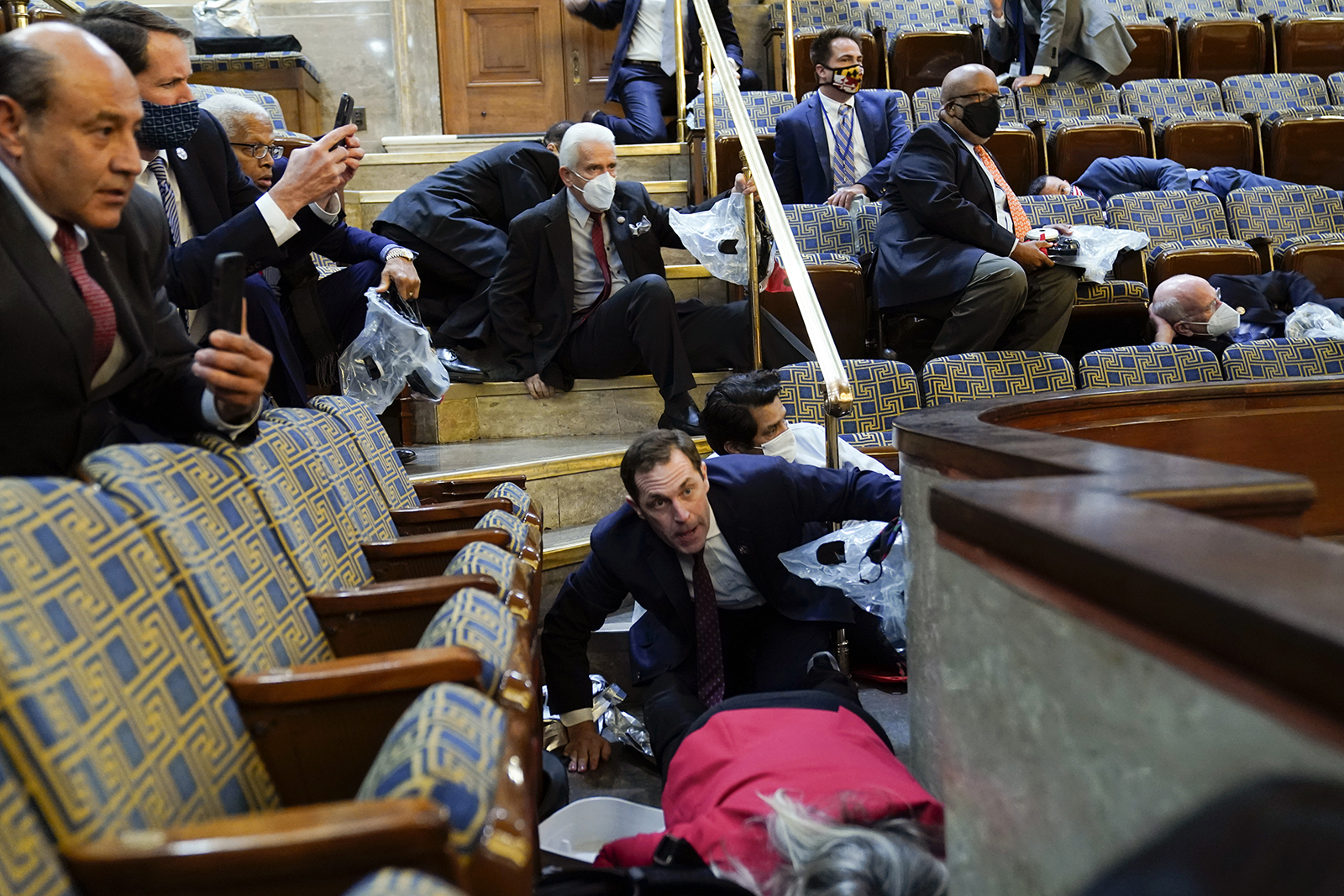
People shelter in the House gallery as protesters try to break into the House chamber at the U.S. Capitol on Jan. 6, 2021, in Washington. (AP Photo/Andrew Harnik)
Lawmakers appeared largely convinced by the report, peppering the panelists with questions over the course of the hour-long briefing.
“I think the proof points about just how central Christian nationalism — we should call it white Christian nationalism — was to the planning and the execution of the insurrection is really undeniable,” Huffman told Religion News Service in an interview.
Asked by Rep. Jerry McNerney, a California Democrat, to define the “fundamental core” that unites Christian nationalists (“I don’t think it’s belief in Jesus,” McNerney quipped), Perry argued it was an “ethno-culture.”
“This blends the idea of kind of an ethnic identity — this is the white part of it, but also ethnic implies a part of culture,” Perry said. “Religion is a part of this, but also an understanding of white — not necessarily white race, but whiteness. This combination of perceptions (that) the nation rightfully belongs to ‘people like us’ — and by people like us I mean, the ethno-culture, the white Christian conservative, traditionalist, almost certainly native born.”
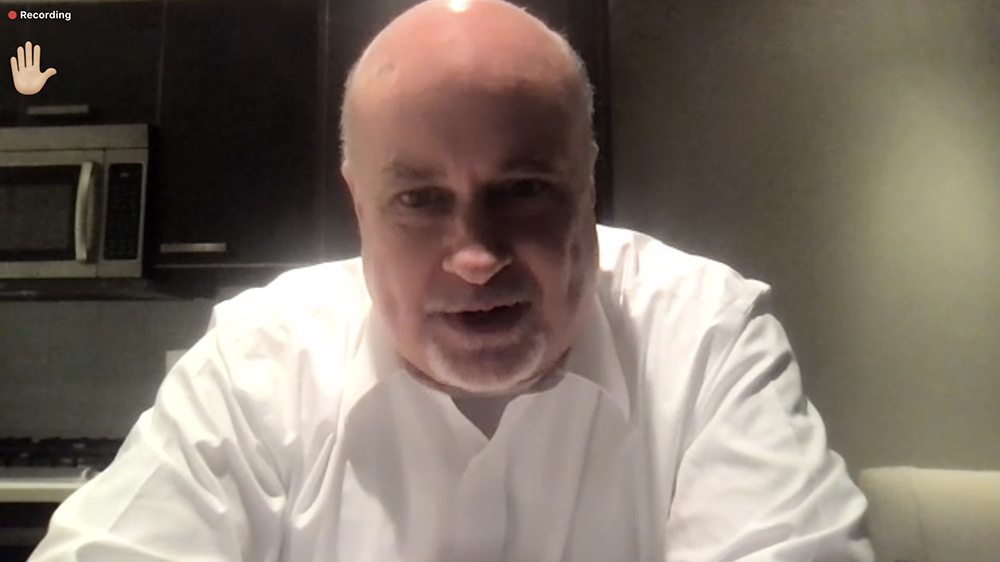
Wisconsin Rep. Mark Pocan on Thursday, March 17, 2022. Video screen grab
Multiple lawmakers, such as Rep. Mark Pocan of Wisconsin, expressed concern about the role of Christian nationalism in ongoing fights with school boards across the country. School board meetings have become a staging ground for heated disputes over COVID-19 restrictions and supposed use of critical race theory, featuring many activists who have invoked religion. Several candidates currently running for school board seats across the country, Pocan said, appear to be tied to Christian nationalism.
Raskin also mentioned Christian nationalism’s pervasive role in ongoing political disputes.
“More than a year later, Christian nationalists continue to join forces to try to challenge our democratic institutions and values — whether it’s in the suppression of voting rights or the promotion of various culture, more battles, including to my mind the utterly fraudulent attack on critical race theory,” he said.
Seidel agreed, noting he planned to send testimony to the Jan. 6 selection committee on the subject. He argued that while there was a “moment of shame” among Christian nationalists immediately following the insurrection, many have since “adopted the insurrection and seem emboldened by it.”
RELATED: For insurrectionists, a violent faith brewed from nationalism, conspiracies and Jesus
He pointed to data showcased by Perry during his presentation that showed shifting views of the insurrection among Christian nationalists over the past year. In February 2021, immediately after the insurrection, 75% of white Americans who scored highest on Perry’s Christian nationalism index — a series of questions that gauge Christian nationalism — said those who attacked the Capitol should be caught and prosecuted. By August of that same year, the number dropped to only 54%.
By contrast, those who scored the lowest on the Christian nationalism index barely budged in that same timeframe, with around 95% saying both times they were asked that the insurrectionists should be caught and put on trial.
Similarly, slightly less than 15% of hardline Christian nationalists in February 2021 agreed with the statement “I stand with the protesters who stormed the Capitol.” Come August, that number went up to 26%.
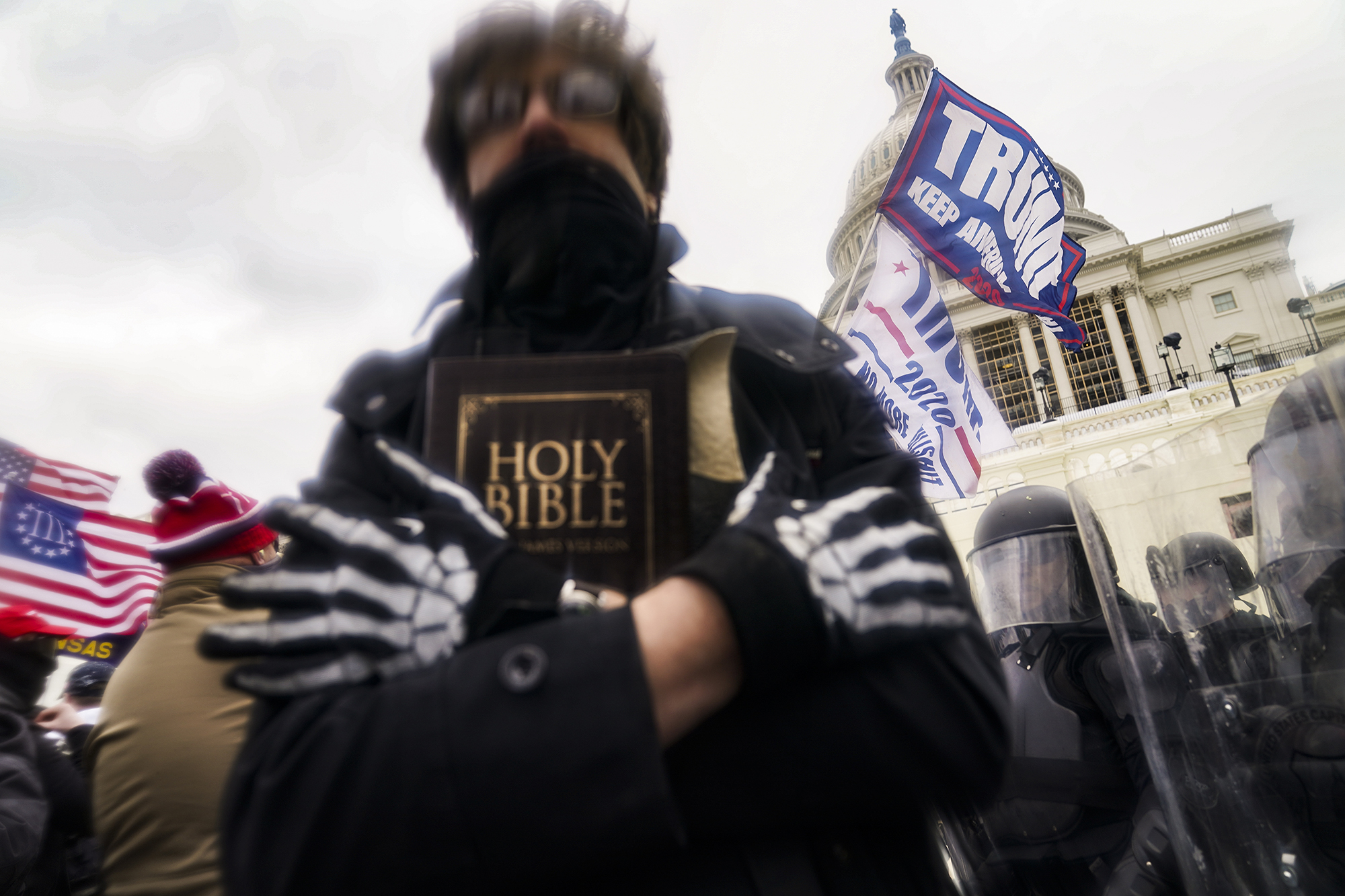
FILE – In this Wednesday, Jan. 6, 2021 file photo, a man holds a Bible as Trump supporters gather outside the Capitol in Washington. (AP Photo/John Minchillo)
Raskin also asked whether panelists believed Christian nationalism played any role in inspiring what he described as “the medieval violence” of Jan. 6.
Seidel responded by arguing that prominent Christian nationalists used “very militant” language in the lead up to Jan. 6, often couched in the rhetoric of “spiritual warfare.”
Among the incidents chronicled in the report is a speech by Stewart Rhodes, the leader of the militant group Oath Keepers, who is currently facing sedition charges for his alleged role in the insurrection. Delivered at a faith-themed “Jericho March” event in Washington, D.C., on December 12, 2020, Rhodes threatened a “bloody war” if the 2020 election results weren’t overturned.
When he finished, the event’s emcee, conservative Christian commentator Eric Metaxas, responded: “Oh, God bless you. This guy’s keepin’ it real, folks.”
Similarly, the night before the insurrection, Tennessee Pastor Greg Locke stood before a crowd in Washington and prayed for Enrique Tarrio, the leader of the militant group Proud Boys who now also faces charges related to the insurrection. Locke said: “We just thank God that we can lock shields, and we can come shoulder-to-shoulder with people that still stand up for this nation … God, help us to live, help us to fight, and if need be, lay down our life for this nation.”
Tisby added that historical efforts to “enforce this vision of a white Christian nationalist America” — particularly those used to further racist goals — often didn’t have to use explicit calls to violence. He pointed to the example of onetime Mississippi senator and Ku Klux Klan member Theodore G. Bilbo, who declared in 1946 that the best time to stop Black people from voting is “the night before.”
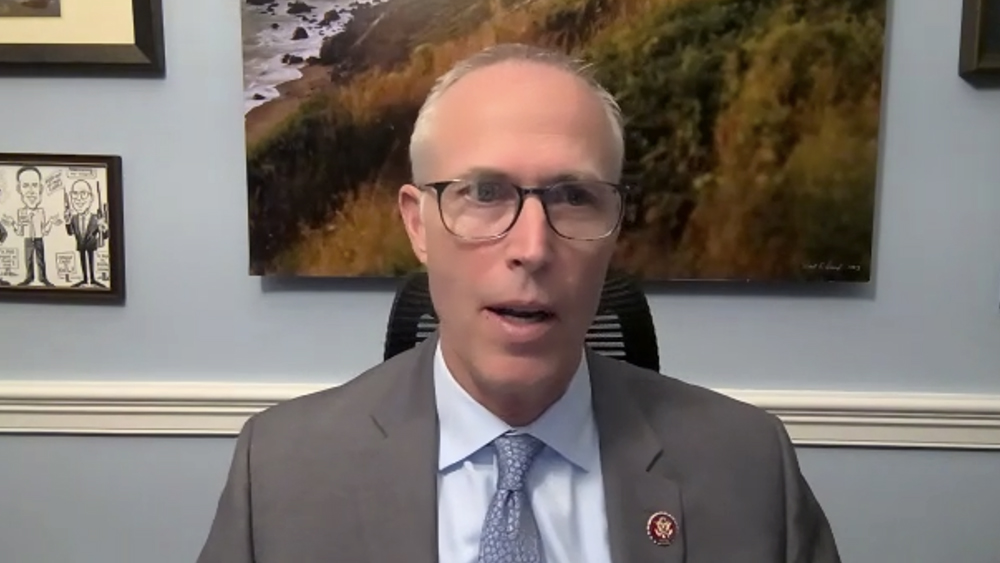
California Rep. Jared Huffman on Thursday, March 17, 2022. Video screen grab
Huffman closed out the meeting by asking panelists how best to combat Christian nationalism. The panel advocated for an embrace of the separation of church and state, the building of a “coalition of the religious willing” to combat Christian nationalism and the marginalization of the ideology.
Huffman echoed the panelists after the event, saying the “antidote” to Christian nationalism is “defending the line of separation between church and state.” The Freethought Caucus, he said, will continue to stay engaged with dialogue around Christian nationalism in the future.
In the meantime, questions remain as to how to broach the topic of Christian nationalism among his colleagues on Capitol Hill. Asked after the event whether he saw Christian nationalism among members of Congress ahead of the insurrection, Huffman laughed, replying: “Is that a rhetorical question? Of course.”
“We had colleagues at the ellipse for the pep rally that launched the insurrection,” he said, referring to the rally in support for former President Donald Trump that immediately preceded the Capitol attack. “If you look at their talking points, they just check every box on the white Christian nationalist agenda.”
From the new Christian right to Christian nationalism, part 1
Up first, the 20th century.
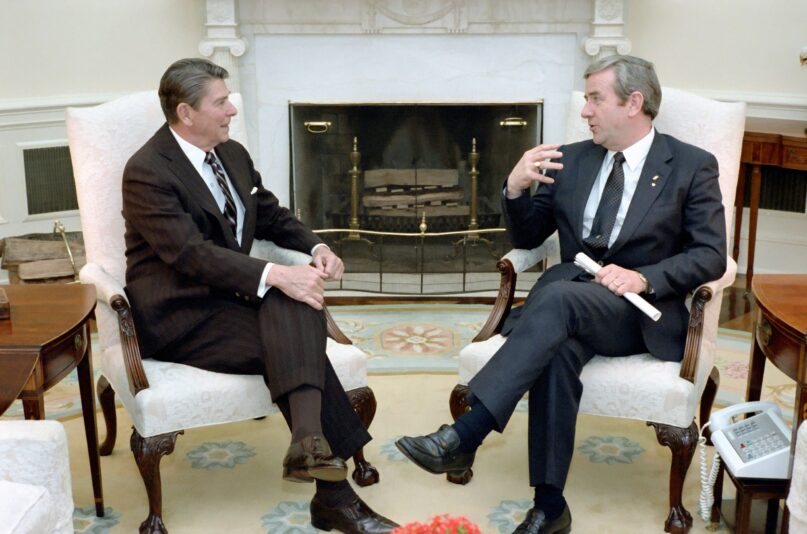
(RNS) — When I first began studying religion and American politics 40 years ago, the new kid on the block was the new Christian right. Its avatar was the late Jerry Falwell Sr., pastor of an independent Baptist church in Lynchburg, Virginia, and a self-promoter eager to lead an evangelical crusade against feminism and gay rights.
In the 1970s, white evangelicals were in thrall to the premillennialism of Hal Lindsey’s mega-bestseller “The Late Great Planet Earth.” It taught that moral corruption had taken over the world, America was no better than any other country and Christians should content themselves with going to church and evangelizing others in preparation for the imminent End Times.
In countering his co-religionists’ political quiescence, Falwell flew something of a false flag. His social values were not “Christian” but “Judeo-Christian,” his organization, the nominally inclusive Moral Majority, Inc. This was not to look like a Christian political crusade.
But when other evangelical leaders joined GOP operatives to activate evangelicals as Republican voters, it was impossible to doubt what this movement was about. And with the election of Ronald Reagan and the defeat of a clutch of Democratic senators in 1980, the New Christian Right became a thing to be reckoned with.
Reagan himself steered clear of the rhetoric of crusade, conjuring up instead the restoration of an idealized America he liked to call “the shining city on a hill.” This was, as he put it in his farewell address, “a tall, proud city built on rocks stronger than oceans, windswept, God-blessed, and teeming with people of all kinds living in harmony and peace; a city with free ports that hummed with commerce and creativity. And if there had to be city walls, the walls had doors and the doors were open to anyone with the will and the heart to get here.”
By the 1988 election cycle, the Christian Right (no longer new) had established itself as an essential component of the Republican coalition. That year witnessed a surprisingly successful run for the GOP presidential nomination by pentecostal Pat Robertson, proprietor of the Christian Broadcasting Network and host of its daily newsmagazine, “The 700 Club.”
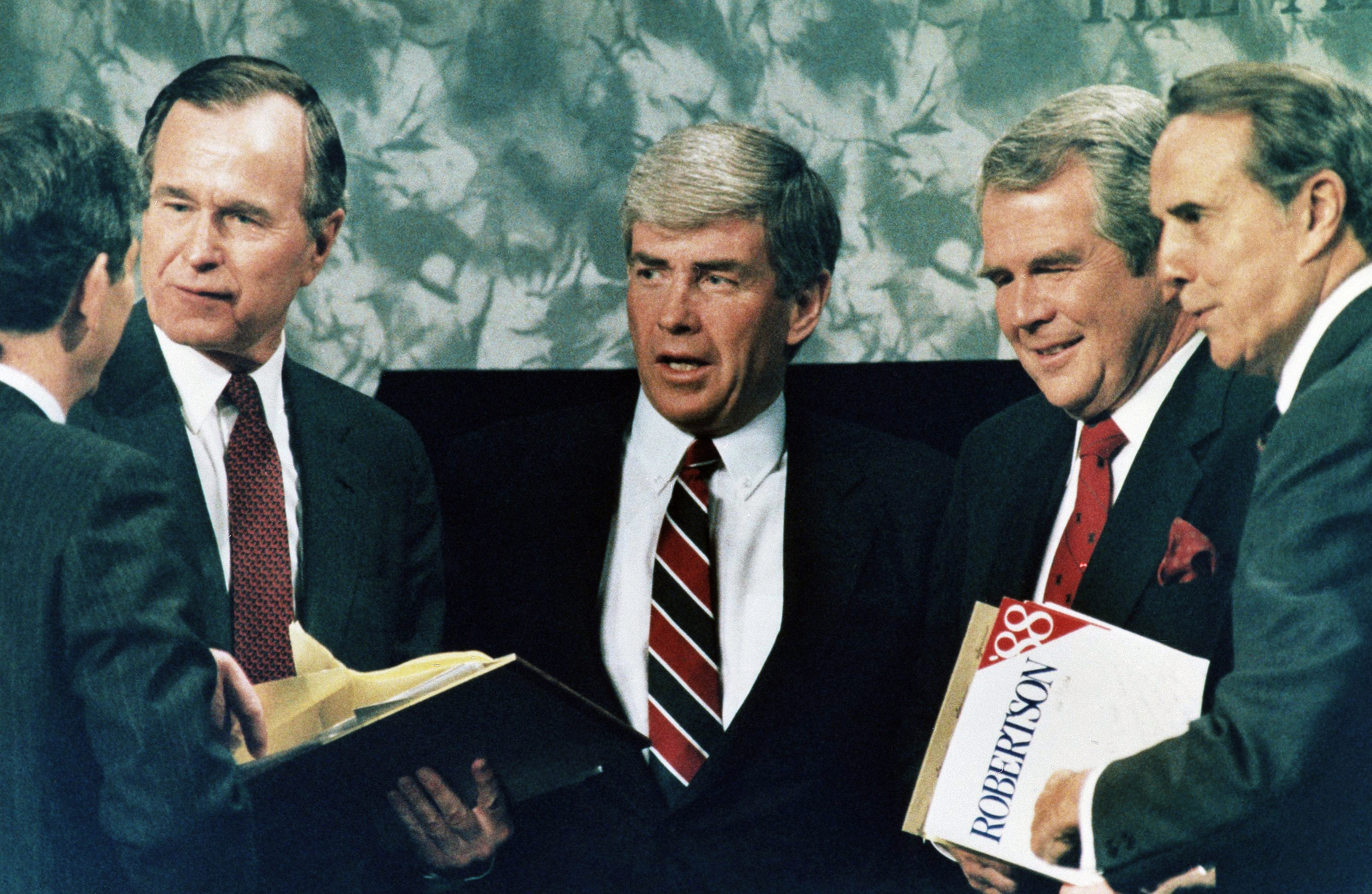
Republican presidential candidates in 1988 included, from left, Vice President George Bush, Rep. Jack Kemp, Pat Robertson, and Sen. Robert Dole after a debate in Atlanta on Feb. 28, 1988. (AP Photo)
Robertson’s campaign slogan, “For God and Country,” injected a nationalistic theme into the Christian right that would swell over time. After Vice President George H.W. Bush defeated him for the nomination and then won the presidency, Robertson established the Christian Coalition, which quickly replaced the Moral Majority as the movement’s marquee organization, doing serious grass-roots organizing under the direction of GOP wunderkind Ralph Reed.
The strategy of both the Reagan and Bush administrations was to give the Christian right — or religious right, as Falwell among others called it — a good deal of lip service but limited concrete action. This left a sizable cohort ready to follow former Nixon speechwriter Pat Buchanan in his insurgent effort to wrest the presidential nomination from Bush in 1992.
Buchanan’s campaign slogan, “America First,” harked back to the America First isolationists who opposed U.S. entry into World War II and whose most prominent figure was Nazi sympathizer Charles Lindbergh. Speaking in support of Bush’s renomination at the 1992 Republican Convention, Buchanan hurled down the gauntlet of religious nationalism.
“There is a religious war going on in this country,” he declared. “It is a cultural war, as critical to the kind of nation we shall be as was the Cold War itself, for this war is for the soul of America.” Where Reagan’s vision was that of an open and inclusive American civil religion, Buchanan invoked what the Italian scholar of Fascism Emilio Gentile calls a “political religion” — an intolerant and exclusivist sacralization of the nation for use as a weapon in partisan combat.
Four years later, Buchanan was out on the presidential hustings again, and while he was only modestly more successful against the establishment’s candidate (Sen. Bob Dole of Kansas) than he’d been against Bush in 1992, shrewd insiders like William Kristol, then editor of the conservative Weekly Standard, perceived him, rather than the pro-Dole Ralph Reed, as the real leader of the Christian right.
“Pat Buchanan has now taken over a movement that Pat Robertson and Ralph Reed spent eight years building up,” Kristol told The Washington Post early in the 1996 primary season. “Ralph Reed thinks the way to win the culture war over the long term is to damp down the enthusiasm of some of his followers and lead a long march through the institutions. Pat Buchanan wants to lead a fixed bayonet charge on the elites right now. It is a very different political strategy and implies a different agenda.”
That strategy would have to wait 20 years to come to fruition.
The story next time, in part 2.
From new Christian right to Christian nationalism, part 2
And, now on to the 21st century.

(RNS) — George W. Bush may have been the closest thing the Christian right had to a president who was one of them, but his eight years in office did little to further their political religion. The faith-based initiative that marked his first months in office was about the common good, not the culture war.
RELATED: From the new Christian right to Christian nationalism, part 1
Immediately after the attacks of 9/11, Bush visited Washington’s Islamic Center to deny that terrorism was “the faith of Islam,” thereby signaling the U.S. response would not be a religious crusade. His wars in Afghanistan and Iraq harked back to Woodrow Wilson’s make-the-world-safe-for-democracy idealism, not Lindbergh’s America First isolationism.
But the gradualist political strategy pioneered by the Christian Coalition’s Ralph Reed proceeded apace. In the early 2000s, white evangelicals became solidly locked into the Republican Party, and they have voted for GOP presidential and congressional candidates by 4-1 margins ever since. In 2002, Reed gave an object lesson in faith-based mobilization as chairman of the Georgia Republican Party when he flipped the state from Democratic to Republican control.
After Bush left office and Barack Obama assumed the presidency, the wheels of Buchanan-style political religion began to turn freely again. Hostility to Islam became a wedge issue through the birtherism that made Obama out to be a Muslim born in Kenya, the Fox News-driven “ground zero mosque” controversy and state referendums against the establishment of “Shariah law.”
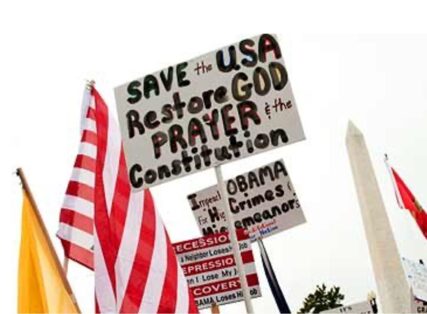
Tea party rally. Photo by Nicholas Kamm AFC
The 2010 midterms featured the tea party — or, to be precise, sundry organizations that bore its name. Created to protest taxes and the Affordable Care Act, the organizations drew heavily on white evangelicals, who were five times more likely to support than oppose it. Decked out in Revolutionary War garb, the partiers presented themselves as God-and-country patriots.
The tea party turned out to be a warmup for Donald Trump, who made white evangelicals his most fervent supporters as he constructed an America First ideology based on Islamophobia, closed borders, beggar-thy-neighbor tariffs and religious liberty for his religious supporters. What fireside chats were for Franklin Delano Roosevelt’s presidency, political rallies were for Trump’s. The Jan. 6 assault on the Capitol was their apotheosis.
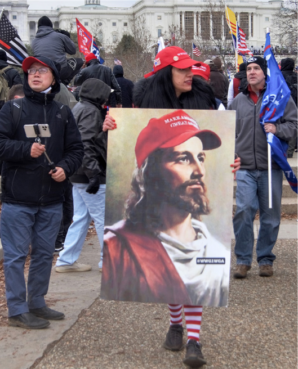
White #MAGA QAnon Jesus carried during the Jan. 6 invasion of the Capitol. Photo by Tyler Merbler / Flickr
“Thank you divine, omniscient, omnipotent and omnipresent creator God, for filling this chamber with your white light of love, with your white light of harmony,” prayed Jacob Chansley, the so-called QAnon Shaman, on the Senate dais that day. “Thank you for filling this chamber with patriots that love you and that love Christ.”
The role of religion in the assault on the Capitol was detailed last week in a report from the Baptist Joint Committee and the Freedom From Religion Foundation titled “Christian Nationalism and the January 6, 2021 Insurrection.” In the introduction, the BJC’s Amanda Tyler defines Christian nationalism as “a political ideology and cultural framework that seeks to merge American and Christian identities, distorting both the Christian faith and America’s constitutional democracy.”
It would be more accurate to call this merging of identities Christian Americanism — the political religion of the Trumpist GOP.
No single piece of iconography better conveys this religion than “One Nation Under God,” the painting by Jon McNaughton reproduced at the top of this column. Based on medieval portrayals of the Last Judgment, it shows Jesus holding the U.S. Constitution, flanked by the country’s saints, with the saved (pious citizens) at the lower left and the damned (journalists, professors, feminists) at the lower right.
McNaughton is not an evangelical but a member of The Church of Jesus Christ of Latter-day Saints. That Christian Americanism considers the Constitution God-given is thanks to Mormon doctrine going back to Joseph Smith that it is so.
No comments:
Post a Comment